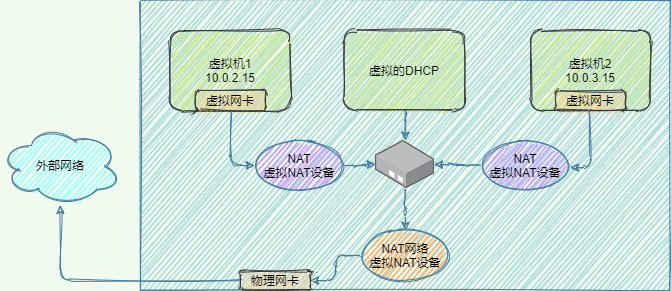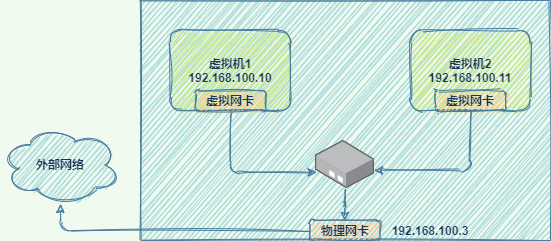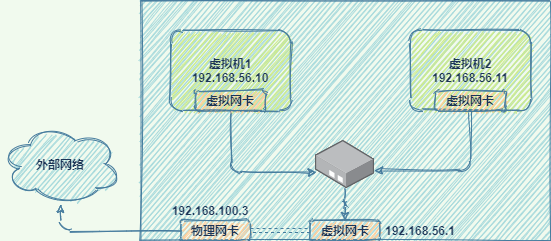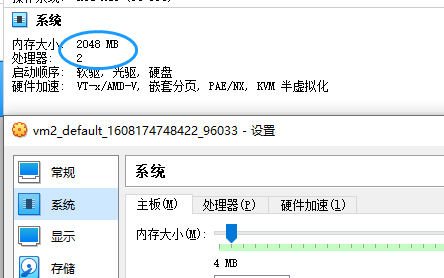从零搭建K8S测试集群
环境准备
本文介绍从零开始创建多个虚拟机,组建一个测试k8s集群的完整过程,并记录中间踩过的坑
创建虚拟机
安装vagrant和virtualbox
创建两个目录(一个目录对应一个虚拟机),进入执行vagrant init centos/7初始化,以及vagrant up,然后去吃饭,等待虚拟机装好
D:\vm2>vagrant init centos/7
A `Vagrantfile` has been placed in this directory. You are now
ready to `vagrant up` your first virtual environment! Please read
the comments in the Vagrantfile as well as documentation on
`vagrantup.com` for more information on using Vagrant.
D:\vm2>vagrant up
Bringing machine 'default' up with 'virtualbox' provider...
==> default: Importing base box 'centos/7'...
==> default: Matching MAC address for NAT networking...
==> default: Checking if box 'centos/7' version '2004.01' is up to date...
==> default: Setting the name of the VM: vm2_default_1608174748422_96033
==> default: Fixed port collision for 22 => 2222. Now on port 2200.
==> default: Clearing any previously set network interfaces...
==> default: Preparing network interfaces based on configuration...
default: Adapter 1: nat
==> default: Forwarding ports...
default: 22 (guest) => 2200 (host) (adapter 1)
==> default: Booting VM...
==> default: Waiting for machine to boot. This may take a few minutes...
default: SSH address: 127.0.0.1:2200
default: SSH username: vagrant
default: SSH auth method: private key
default:
default: Vagrant insecure key detected. Vagrant will automatically replace
default: this with a newly generated keypair for better security.
default:
default: Inserting generated public key within guest...
default: Removing insecure key from the guest if it's present...
default: Key inserted! Disconnecting and reconnecting using new SSH key...
==> default: Machine booted and ready!
==> default: Checking for guest additions in VM...
default: No guest additions were detected on the base box for this VM! Guest
default: additions are required for forwarded ports, shared folders, host only
default: networking, and more. If SSH fails on this machine, please install
default: the guest additions and repackage the box to continue.
default:
default: This is not an error message; everything may continue to work properly,
default: in which case you may ignore this message.
==> default: Rsyncing folder: /cygdrive/d/vm2/ => /vagrant
vagrant会帮我们把虚拟机装好并启动,创建一个vagrant账号,密码vagrant,root账号的密码也是vagrant。同时,在当前的目录下生成一个Vagrantfile文件,我们需要对这个文件做一点小小的修改来保证虚拟机的设置满足k8s需求,以及虚拟机之间的网络可以互通。
# 配置一个公共网络(bridge网络,可以指定ip,也可以不指定,使用默认的dhcp分配地址)
config.vm.network "public_network", ip: "192.168.56.10"
config.vm.provider "virtualbox" do |vb|
# Display the VirtualBox GUI when booting the machine
# vb.gui = true
# 指定内存和cpu核数
# Customize the amount of memory on the VM:
vb.memory = "4096"
vb.cpus = 2
end
修改好后执行vagrant reload即可重启虚拟机,让配置生效
bridge网络默认虚拟机可以ping其它虚拟机,但宿主机无法ping通虚拟机,如果指定了和宿主机同一个网段(需要确认指定的ip是空闲的),宿主机可以ping通虚拟机,但虚拟机无法ping通宿主机,包括默认的dhcp无法为虚拟机分配ip,这应该和公司的网络有关,如果这台虚拟机想要访问其它机器,应该需要先入域才有权限访问!
关于虚拟机的网络
这里介绍一下虚拟机几种主要的网络模型:
- NAT(Network Address Translatation)
- 桥接(Bridge)
- 主机(Host-only)
- 内部(Internal)
NAT
Nat是Vagrant默认设置的网络模型,虚拟机与物理机并不在同一个网段,虚拟机可以访问外网,访问时需要用NAT虚拟设备进行地址转换,严格来讲NAT有2种实现方式:
- NAT:NAT上的虚拟机互相隔离,彼此不能通信,如下图所示,每个虚拟机的虚拟网卡连接着一个虚拟NAT设备(图中紫色NAT,没有橙色的NAT)
- NAT网络:NAT网络上的虚拟机可以互通,共享虚拟NAT设备(图中橙色NAT,没有紫色NAT)

桥接网络
桥接网络简单方便,所有虚拟机和宿主机都在同一个网络中,与宿主机组网的其它机器也可以像访问宿主机一样访问虚拟机,如同一个真实的网络设备一样,是功能最完整的一种网络模型,但缺点是如果虚拟机过多,广播的成本很高

Host-only
主机网络将网络环境限制在主机内部,默认不能访问外网,主机和虚拟机不在同一个网段,但主机与虚拟机之间、虚拟机和虚拟机之间是互通的(通过配置也可以实现对外网的访问)。在主机上设置物理网卡的属性/共享,将物理网卡和虚拟网卡桥接或共享即可访问外网。

内部网络
这是一种简单的网络模型,虚拟机和外部环境完全断开,只允许虚拟机之间互相访问,用的比较少
小结
| Model | VM -> host | host -> VM | VM <-> VM | VM -> Internet | Internet -> VM |
|---|---|---|---|---|---|
| Bridged | + | + | + | + | + |
| NAT | + | Port Forwarding | - | + | Port Forwarding |
| NAT Network | + | Port Forwarding | + | + | Port Forwarding |
| Host-only | + | + | + | - | - |
| Internal | - | - | + | - | - |
关于vagrant的网络
vagrant支持3种网络配置,可以在Vagrantfile中进行配置:
- 端口映射,比如访问本机的8080端口、转发到虚拟机的80端口(默认为tcp,如果需要转发udp则指定Protocol为udp)
config.vm.network "forwarded_port", guest: 80, host: 8080
- 私有网络,对应Host-only网络,允许主机访问虚拟机,以及虚拟机之间互相访问,其它机器无法访问虚拟机,安全性高
config.vm.network "private_network", ip: "192.168.21.4"
- 共有网络,对应bridge网络,相当于一个独立的网络设备
config.vm.network "public_network", ip: "192.168.1.120"
docker安装
docker官方文档 https://docs.docker.com/engine/install/
- 设置官方的软件源
$ sudo yum install -y yum-utils
$ sudo yum-config-manager \
--add-repo \
https://download.docker.com/linux/centos/docker-ce.repo
- 安装docker引擎
$ sudo yum install docker-ce docker-ce-cli containerd.io
- 启动docker
$ sudo systemctl start docker
k8s安装
k8s官方文档 https://kubernetes.io/docs/setup/production-environment/tools/kubeadm/install-kubeadm/
- 确保 iptables 工具不使用 nftables 后端
update-alternatives --set iptables /usr/sbin/iptables-legacy
update-alternatives --set ip6tables /usr/sbin/ip6tables-legacy
update-alternatives --set arptables /usr/sbin/arptables-legacy
update-alternatives --set ebtables /usr/sbin/ebtables-legacy
- 设置源,并安装 kubelet kubeadm kubectl
cat <<EOF > /etc/yum.repos.d/kubernetes.repo
[kubernetes]
name=Kubernetes
baseurl=https://packages.cloud.google.com/yum/repos/kubernetes-el7-x86_64
enabled=1
gpgcheck=1
repo_gpgcheck=1
gpgkey=https://packages.cloud.google.com/yum/doc/yum-key.gpg https://packages.cloud.google.com/yum/doc/rpm-package-key.gpg
EOF
# 将 SELinux 设置为 permissive 模式(相当于将其禁用)
setenforce 0
sed -i 's/^SELINUX=enforcing$/SELINUX=permissive/' /etc/selinux/config
yum install -y kubelet kubeadm kubectl --disableexcludes=kubernetes
systemctl enable --now kubelet
初始化集群
kubeadm init
在主节点上执行kubeadm初始化
[root@localhost vagrant]# kubeadm init
[init] Using Kubernetes version: v1.20.0
[preflight] Running pre-flight checks
[WARNING Service-Docker]: docker service is not enabled, please run 'systemctl enable docker.service'
[WARNING IsDockerSystemdCheck]: detected "cgroupfs" as the Docker cgroup driver. The recommended driver is "systemd". Please follow the guide at https://kubernetes.io/docs/setup/cri/
[WARNING SystemVerification]: this Docker version is not on the list of validated versions: 20.10.1. Latest validated version: 19.03
error execution phase preflight: [preflight] Some fatal errors occurred:
[ERROR NumCPU]: the number of available CPUs 1 is less than the required 2
[ERROR Mem]: the system RAM (486 MB) is less than the minimum 1700 MB
[ERROR FileContent--proc-sys-net-bridge-bridge-nf-call-iptables]: /proc/sys/net/bridge/bridge-nf-call-iptables contents are not set to 1
[ERROR Swap]: running with swap on is not supported. Please disable swap
[preflight] If you know what you are doing, you can make a check non-fatal with `--ignore-preflight-errors=...`
To see the stack trace of this error execute with --v=5 or higher
- docker service is not enabled的告警,直接执行
systemctl enable docker.service解决,docker会被设置为开机自启动 - cgroupfs 问题告警,意思是systemd作为cgroup驱动更加稳定,让你用这个,不同的cri的设置可以参考
https://kubernetes.io/docs/setup/cri/ - docker版本问题告警,我的docker版本过新了,官方还没有测试过,最后一个验证过的版本是19.03
- Error部分CPU和内存不足的问题,打开VirtualBox,在虚拟机的设置中将CPU的核数调整为2或以上、内存大小调整为1700MB或以上即可

- FileContent--proc-sys-net-bridge-bridge-nf-call-iptables问题,iptable被绕过而导致流量无法正确路由,执行下面的命令解决
cat <<EOF > /etc/sysctl.d/k8s.conf
net.bridge.bridge-nf-call-ip6tables = 1
net.bridge.bridge-nf-call-iptables = 1
EOF
sysctl --system
- Swap问题,执行
sudo swapoff -a禁用swap即可,但每次重启都需要重新设置,可以修改/etc/fstab目录下,注释掉swap那行即可
vagrant网络设置
vagrant默认使用nat网络,虽然在虚拟机中可以访问主机和外网,但多个虚拟机之间无法互相访问,
加入集群
我们在主节点上执行kubeadm,注意2点:
- --apiserver-advertise-address "192.168.205.10",指定我们的vm1的eth1网卡,这个网卡才可以和其它vm互通
- --pod-network-cidr=10.244.0.0/16 为使用flannel网络插件做准备
[root@vm1 vagrant]# kubeadm init --apiserver-advertise-address "192.168.205.10" --pod-network-cidr=10.244.0.0/16
[init] Using Kubernetes version: v1.20.0
[preflight] Running pre-flight checks
[WARNING IsDockerSystemdCheck]: detected "cgroupfs" as the Docker cgroup driver. The recommended driver is "systemd". Please follow the guide at https://kubernetes.io/docs/setup/cri/
[WARNING SystemVerification]: this Docker version is not on the list of validated versions: 20.10.1. Latest validated version: 19.03
[preflight] Pulling images required for setting up a Kubernetes cluster
[preflight] This might take a minute or two, depending on the speed of your internet connection
[preflight] You can also perform this action in beforehand using 'kubeadm config images pull'
[certs] Using certificateDir folder "/etc/kubernetes/pki"
[certs] Generating "ca" certificate and key
[certs] Generating "apiserver" certificate and key
[certs] apiserver serving cert is signed for DNS names [kubernetes kubernetes.default kubernetes.default.svc kubernetes.default.svc.cluster.local vm1] and IPs [10.96.0.1 192.168.205.10]
[certs] Generating "apiserver-kubelet-client" certificate and key
[certs] Generating "front-proxy-ca" certificate and key
[certs] Generating "front-proxy-client" certificate and key
[certs] Generating "etcd/ca" certificate and key
[certs] Generating "etcd/server" certificate and key
[certs] etcd/server serving cert is signed for DNS names [localhost vm1] and IPs [192.168.205.10 127.0.0.1 ::1]
[certs] Generating "etcd/peer" certificate and key
[certs] etcd/peer serving cert is signed for DNS names [localhost vm1] and IPs [192.168.205.10 127.0.0.1 ::1]
[certs] Generating "etcd/healthcheck-client" certificate and key
[certs] Generating "apiserver-etcd-client" certificate and key
[certs] Generating "sa" key and public key
[kubeconfig] Using kubeconfig folder "/etc/kubernetes"
[kubeconfig] Writing "admin.conf" kubeconfig file
[kubeconfig] Writing "kubelet.conf" kubeconfig file
[kubeconfig] Writing "controller-manager.conf" kubeconfig file
[kubeconfig] Writing "scheduler.conf" kubeconfig file
[kubelet-start] Writing kubelet environment file with flags to file "/var/lib/kubelet/kubeadm-flags.env"
[kubelet-start] Writing kubelet configuration to file "/var/lib/kubelet/config.yaml"
[kubelet-start] Starting the kubelet
[control-plane] Using manifest folder "/etc/kubernetes/manifests"
[control-plane] Creating static Pod manifest for "kube-apiserver"
[control-plane] Creating static Pod manifest for "kube-controller-manager"
[control-plane] Creating static Pod manifest for "kube-scheduler"
[etcd] Creating static Pod manifest for local etcd in "/etc/kubernetes/manifests"
[wait-control-plane] Waiting for the kubelet to boot up the control plane as static Pods from directory "/etc/kubernetes/manifests". This can take up to 4m0s
[apiclient] All control plane components are healthy after 17.508748 seconds
[upload-config] Storing the configuration used in ConfigMap "kubeadm-config" in the "kube-system" Namespace
[kubelet] Creating a ConfigMap "kubelet-config-1.20" in namespace kube-system with the configuration for the kubelets in the cluster
[upload-certs] Skipping phase. Please see --upload-certs
[mark-control-plane] Marking the node vm1 as control-plane by adding the labels "node-role.kubernetes.io/master=''" and "node-role.kubernetes.io/control-plane='' (deprecated)"
[mark-control-plane] Marking the node vm1 as control-plane by adding the taints [node-role.kubernetes.io/master:NoSchedule]
[bootstrap-token] Using token: 2ckaow.r0ed8bpcy7sdx9kj
[bootstrap-token] Configuring bootstrap tokens, cluster-info ConfigMap, RBAC Roles
[bootstrap-token] configured RBAC rules to allow Node Bootstrap tokens to get nodes
[bootstrap-token] configured RBAC rules to allow Node Bootstrap tokens to post CSRs in order for nodes to get long term certificate credentials
[bootstrap-token] configured RBAC rules to allow the csrapprover controller automatically approve CSRs from a Node Bootstrap Token
[bootstrap-token] configured RBAC rules to allow certificate rotation for all node client certificates in the cluster
[bootstrap-token] Creating the "cluster-info" ConfigMap in the "kube-public" namespace
[kubelet-finalize] Updating "/etc/kubernetes/kubelet.conf" to point to a rotatable kubelet client certificate and key
[addons] Applied essential addon: CoreDNS
[addons] Applied essential addon: kube-proxy
Your Kubernetes control-plane has initialized successfully!
#1.1 特别注意!在开始使用之前,请执行下面这段命令
To start using your cluster, you need to run the following as a regular user:
mkdir -p $HOME/.kube
sudo cp -i /etc/kubernetes/admin.conf $HOME/.kube/config
sudo chown $(id -u):$(id -g) $HOME/.kube/config
#1.2 或者执行下面这一行(如果你是root用户的话)
Alternatively, if you are the root user, you can run:
export KUBECONFIG=/etc/kubernetes/admin.conf
#2 接下来需要部署一个pod网络到集群中
You should now deploy a pod network to the cluster.
Run "kubectl apply -f [podnetwork].yaml" with one of the options listed at:
https://kubernetes.io/docs/concepts/cluster-administration/addons/
#3 然后执行下面的命令将worker节点加入集群
Then you can join any number of worker nodes by running the following on each as root:
kubeadm join 192.168.205.10:6443 --token paattq.r3qp8kksjl0yukls \
--discovery-token-ca-cert-hash sha256:f18d1e87c8b1d041bc7558eedd2857c2ad7094b1b2c6aa8388d0ef51060e4c0f
配置kubeconfig
按照kubeadm的提示,需要先执行下面这段代码配置kubeconfig才可以正常访问到集群
mkdir -p $HOME/.kube
sudo cp -i /etc/kubernetes/admin.conf $HOME/.kube/config
sudo chown $(id -u):$(id -g) $HOME/.kube/config
否则会出现以下问题,执行完上面的方法后再执行kubectl get nodes就正常了
[root@vm1 vagrant]# kubectl get nodes
The connection to the server localhost:8080 was refused - did you specify the right host or port?
或者:
[root@vm1 vagrant]# kubectl get nodes
Unable to connect to the server: x509: certificate signed by unknown authority (possibly because of "crypto/rsa: verification error" while trying to verify candidate authority certificate "kubernetes")
此时查看以下k8s内部pod的运行状态,可以发现,只有kube-proxy和kube-apiserver处于就绪状态
[root@vm1 vagrant]# kubectl get pods -n kube-system
NAME READY STATUS RESTARTS AGE
coredns-74ff55c5b-4ndtt 0/1 ContainerCreating 0 43s
coredns-74ff55c5b-tmc7n 0/1 ContainerCreating 0 43s
etcd-vm1 0/1 Running 0 51s
kube-apiserver-vm1 1/1 Running 0 51s
kube-controller-manager-vm1 0/1 Running 0 51s
kube-proxy-5mvwf 1/1 Running 0 44s
kube-scheduler-vm1 0/1 Running 0 51s
部署pod网络
接下来需要部署Pod网络,否则我们观察到的节点会是NotReady的状态,如下所示
[root@vm1 vagrant]# kubectl get nodes
NAME STATUS ROLES AGE VERSION
vm1 NotReady control-plane,master 4m v1.20.0
具体使用哪一个网络,可以参考https://kubernetes.io/docs/concepts/cluster-administration/addons/,这里选择了大名鼎鼎的flannel插件,在使用kubeadm时,flannel要求我们在kubeadm init时指定--pod-network-cidr参数来初始化cidr。
NOTE: If kubeadm is used, then pass --pod-network-cidr=10.244.0.0/16 to kubeadm init to ensure that the podCIDR is set.
另外,由于这里我们使用的是vagrant创建的虚拟机,默认的eth0网卡是一个nat网卡,只能从虚拟机访问外部,不能从外部访问虚拟机内部,所以我们需要指定一个可以和外部通信的bridge网卡——eth1,修改kube-flannel.yml,添加--iface=eth1参数指定网卡。
containers:
- name: kube-flannel
image: quay.io/coreos/flannel:v0.13.1-rc1
command:
- /opt/bin/flanneld
args:
- --ip-masq
- --kube-subnet-mgr
- --iface=eth1 # 为kube-flannel容器指定额外的启动参数!
执行下面的命令,可以创建flannel网络
wget https://raw.githubusercontent.com/coreos/flannel/master/Documentation/k8s-manifests/kube-flannel.yml
kubectl apply -f kube-flannel.yml
部署完网络后,再过一会儿查看k8s的pod状态可以发现,所有的pod都就绪了,并且启动了一个新的kube-flannel-ds
[root@vm1 vagrant]# kubectl get pods -n kube-system
NAME READY STATUS RESTARTS AGE
coredns-74ff55c5b-4ndtt 1/1 Running 0 88s
coredns-74ff55c5b-tmc7n 1/1 Running 0 88s
etcd-vm1 1/1 Running 0 96s
kube-apiserver-vm1 1/1 Running 0 96s
kube-controller-manager-vm1 1/1 Running 0 96s
kube-flannel-ds-dnw4d 1/1 Running 0 19s
kube-proxy-5mvwf 1/1 Running 0 89s
kube-scheduler-vm1 1/1 Running 0 96s
加入集群
最后在vm2上执行kubeadm join加入集群
[root@vm2 vagrant]# kubeadm join 192.168.205.10:6443 --token paattq.r3qp8kksjl0yukls \
> --discovery-token-ca-cert-hash sha256:f18d1e87c8b1d041bc7558eedd2857c2ad7094b1b2c6aa8388d0ef51060e4c0f
[preflight] Running pre-flight checks
[WARNING IsDockerSystemdCheck]: detected "cgroupfs" as the Docker cgroup driver. The recommended driver is "systemd". Please follow the guide at https://kubernetes.io/docs/setup/cri/
[WARNING SystemVerification]: this Docker version is not on the list of validated versions: 20.10.1. Latest validated version: 19.03
[preflight] Reading configuration from the cluster...
[preflight] FYI: You can look at this config file with 'kubectl -n kube-system get cm kubeadm-config -o yaml'
[kubelet-start] Writing kubelet configuration to file "/var/lib/kubelet/config.yaml"
[kubelet-start] Writing kubelet environment file with flags to file "/var/lib/kubelet/kubeadm-flags.env"
[kubelet-start] Starting the kubelet
[kubelet-start] Waiting for the kubelet to perform the TLS Bootstrap...
This node has joined the cluster:
* Certificate signing request was sent to apiserver and a response was received.
* The Kubelet was informed of the new secure connection details.
Run 'kubectl get nodes' on the control-plane to see this node join the cluster.
加入之后,运行ip a可以查看到我们的网络,k8s为我们额外启动了flannel.1、cni0、以及veth设备
[root@vm2 vagrant]# ip a
1: lo: <LOOPBACK,UP,LOWER_UP> mtu 65536 qdisc noqueue state UNKNOWN group default qlen 1000
link/loopback 00:00:00:00:00:00 brd 00:00:00:00:00:00
inet 127.0.0.1/8 scope host lo
valid_lft forever preferred_lft forever
inet6 ::1/128 scope host
valid_lft forever preferred_lft forever
2: eth0: <BROADCAST,MULTICAST,UP,LOWER_UP> mtu 1500 qdisc pfifo_fast state UP group default qlen 1000
link/ether 52:54:00:4d:77:d3 brd ff:ff:ff:ff:ff:ff
inet 10.0.2.15/24 brd 10.0.2.255 scope global noprefixroute dynamic eth0
valid_lft 85901sec preferred_lft 85901sec
inet6 fe80::5054:ff:fe4d:77d3/64 scope link
valid_lft forever preferred_lft forever
3: eth1: <BROADCAST,MULTICAST,UP,LOWER_UP> mtu 1500 qdisc pfifo_fast state UP group default qlen 1000
link/ether 08:00:27:f1:20:55 brd ff:ff:ff:ff:ff:ff
inet 192.168.205.11/24 brd 192.168.205.255 scope global noprefixroute eth1
valid_lft forever preferred_lft forever
inet6 fe80::a00:27ff:fef1:2055/64 scope link
valid_lft forever preferred_lft forever
4: docker0: <NO-CARRIER,BROADCAST,MULTICAST,UP> mtu 1500 qdisc noqueue state DOWN group default
link/ether 02:42:6f:03:4a:68 brd ff:ff:ff:ff:ff:ff
inet 172.17.0.1/16 brd 172.17.255.255 scope global docker0
valid_lft forever preferred_lft forever
5: flannel.1: <BROADCAST,MULTICAST,UP,LOWER_UP> mtu 1450 qdisc noqueue state UNKNOWN group default
link/ether 6e:99:9d:7b:08:ec brd ff:ff:ff:ff:ff:ff
inet 10.244.1.0/32 brd 10.244.1.0 scope global flannel.1
valid_lft forever preferred_lft forever
inet6 fe80::6c99:9dff:fe7b:8ec/64 scope link
valid_lft forever preferred_lft forever
6: cni0: <BROADCAST,MULTICAST,UP,LOWER_UP> mtu 1450 qdisc noqueue state UP group default qlen 1000
link/ether 4a:fe:72:33:fc:85 brd ff:ff:ff:ff:ff:ff
inet 10.244.1.1/24 brd 10.244.1.255 scope global cni0
valid_lft forever preferred_lft forever
inet6 fe80::48fe:72ff:fe33:fc85/64 scope link
valid_lft forever preferred_lft forever
7: veth7981bae1@if3: <BROADCAST,MULTICAST,UP,LOWER_UP> mtu 1450 qdisc noqueue master cni0 state UP group default
link/ether 1a:87:b6:82:c7:5c brd ff:ff:ff:ff:ff:ff link-netnsid 0
inet6 fe80::1887:b6ff:fe82:c75c/64 scope link
valid_lft forever preferred_lft forever
8: veth54bbbfd5@if3: <BROADCAST,MULTICAST,UP,LOWER_UP> mtu 1450 qdisc noqueue master cni0 state UP group default
link/ether 46:36:5d:96:a0:69 brd ff:ff:ff:ff:ff:ff link-netnsid 1
inet6 fe80::4436:5dff:fe96:a069/64 scope link
valid_lft forever preferred_lft forever
此时再在vm1上查看节点状态,可以看到有2个就绪的节点
[root@vm1 vagrant]# kubectl get nodes
NAME STATUS ROLES AGE VERSION
vm1 Ready control-plane,master 5h58m v1.20.0
vm2 Ready <none> 5h54m v1.20.0
部署一个服务
现在我们有了一个简单的k8s环境,来部署一个简单的nginx服务测试一下吧,首先准备一个nginx-deployment.yaml文件,内容如下
apiVersion: apps/v1
kind: Deployment
metadata:
name: nginx-deployment
labels:
app: nginx
spec:
replicas: 2
selector:
matchLabels:
app: nginx
template:
metadata:
labels:
app: nginx
spec:
containers:
- name: nginx
image: nginx:latest
ports:
- containerPort: 80
执行kubectl apply进行部署
[root@vm1 vagrant]# kubectl apply -f nginx-deployment.yaml
deployment.apps/nginx-deployment created
可以查看一下Pod有没有起来
[root@vm1 vagrant]# kubectl get pods
NAME READY STATUS RESTARTS AGE
nginx-deployment-585449566-bqls4 1/1 Running 0 20s
nginx-deployment-585449566-n8ssk 1/1 Running 0 20s
再执行kubectl expose添加一个service导出
[root@vm1 vagrant]# kubectl expose deployment nginx-deployment --port=80 --type=NodePort
service/nginx-deployment exposed
kubectl get svc查看一下映射的端口
[root@vm1 vagrant]# kubectl get svc
NAME TYPE CLUSTER-IP EXTERNAL-IP PORT(S) AGE
kubernetes ClusterIP 10.96.0.1 <none> 443/TCP 4m19s
nginx-deployment NodePort 10.98.176.208 <none> 80:32033/TCP 8s
指定导出的端口用curl进行测试
[root@vm1 vagrant]# curl -I 192.168.205.11:32033
HTTP/1.1 200 OK
Server: nginx/1.19.6
Date: Mon, 21 Dec 2020 07:09:40 GMT
Content-Type: text/html
Content-Length: 612
Last-Modified: Tue, 15 Dec 2020 13:59:38 GMT
Connection: keep-alive
ETag: "5fd8c14a-264"
Accept-Ranges: bytes
参考
- https://github.com/rootsongjc/kubernetes-vagrant-centos-cluster/blob/master/README-cn.md
- https://my.oschina.net/xuthus/blog/3131077
- https://my.oschina.net/u/3683692/blog/3025611
- https://cloud.tencent.com/developer/article/1460094
- https://www.kubernetes.org.cn/5551.html
- https://cloud.tencent.com/developer/article/1432433
从零搭建K8S测试集群的更多相关文章
- 从零搭建mongo分片集群的简洁方法
一.目录 1.mongo路径,config数据路径,shard数据路径
- CentOS完美搭建Redis3.0集群并附测试
线上的统一聊天和推送项目使用的是redis主从,redis版本2.8.6 redis主从和mysql主从目的差不多,但redis主从配置很简单,主要在从节点配置文件指定主节点ip和端口:slaveof ...
- redis安装、测试&集群的搭建&踩过的坑
1 redis的安装 1.1 安装redis 版本说明 本教程使用redis3.0版本.3.0版本主要增加了redis集群功能. 安装的前提条件: 需要安装gcc:yum install gcc- ...
- centos7搭建ELK Cluster集群日志分析平台(四):Fliebeat-简单测试
续之前安装好的ELK集群 各主机:es-1 ~ es-3 :192.168.1.21/22/23 logstash: 192.168.1.24 kibana: 192.168.1.25 测试机:cli ...
- .net core i上 K8S(一)集群搭建
1.前言 以前搭建集群都是使用nginx反向代理,但现在我们有了更好的选择——K8S.我不打算一上来就讲K8S的知识点,因为知识点还是比较多,我打算先从搭建K8S集群讲起,我也是在搭建集群的过程中熟悉 ...
- 简单了解一下K8S,并搭建自己的集群
距离上次更新已经有一个月了,主要是最近工作上的变动有点频繁,现在才暂时稳定下来.这篇博客的本意是带大家从零开始搭建K8S集群的.但是我后面一想,如果是我看了这篇文章,会收获什么?就是跟着步骤一步一走吗 ...
- 使用国内的镜像源搭建 kubernetes(k8s)集群
1. 概述 老话说的好:努力学习,提高自己,让自己知道的比别人多,了解的别人多. 言归正传,之前我们聊了 Docker,随着业务的不断扩大,Docker 容器不断增多,物理机也不断增多,此时我们会发现 ...
- 使用Rancher搭建K8S测试环境
使用Rancher搭建K8S测试环境 http://blog.csdn.net/csdn_duomaomao/article/details/75316926 环境准备(4台主机,Ubuntu16.0 ...
- ZooKeeper环境搭建(单机/集群)(转)
前提: 配置文件主要是在$ZOOKEEPER_HOME/conf/zoo.cfg,刚解压时为zoo_sample.cfg,重命名zoo.cfg即可. 配置文件常用项参考:http://www.cnbl ...
随机推荐
- php进阶学习-单例设计模式
什么是单例模式(singleton)? 在整个应用程序的生命周期中,任何一个时刻,单例类的实例都只存在一个,同时这个类还必须提供一个访问该类的全局访问点. 单例模式的特点 一个类只有一个实例 私有克隆 ...
- Django中ModelForm详解
1.ModelForm组件介绍:这个组件的功能就是把model和form组合起来 2.ModelForm的使用 1.首先需要导入ModelForm from django.forms import M ...
- 导出mysql内数据 python建倒排索引
根据mysql内数据,python建倒排索引,再导回mysql内. 先把mysql内的数据导出,先导出为csv文件,因为有中文,直接打开csv文件会乱码,再直接改文件的后缀为txt,这样打开时不会是乱 ...
- 基于 MongoDB 动态字段设计的探索
一.业务需求 假设某学校课程系统,不同专业课程不同 (可以动态增删),但是需要根据专业不同显示该专业学生的各科课程的成绩,如下: 专业 姓名 高等数学 数据结构 计算机 张三 90 85 计算机 李四 ...
- R语言无网络安装R包,彻底解决依赖问题!
R version: 3.5.3, 3.6.3 更新日期: 2020-9-10 大家测试后多提建议哈, 有问题我会持续更新的 在工作中,我们使用的服务器通常是不能联外网的,这在安装R包的时候产生了巨大 ...
- RabbitMQ Go客户端教程5——topic
本文翻译自RabbitMQ官网的Go语言客户端系列教程,本文首发于我的个人博客:liwenzhou.com,教程共分为六篇,本文是第五篇--topic. 这些教程涵盖了使用RabbitMQ创建消息传递 ...
- PyQt(Python+Qt)学习随笔:树型部件QTreeWidget中判断项是否首列跨所有列展示的isFirstItemColumnSpanned方法
老猿Python博文目录 专栏:使用PyQt开发图形界面Python应用 老猿Python博客地址 在前面<PyQt(Python+Qt)学习随笔:QTreeWidgetItem项是否首列跨所有 ...
- Python Flask后端异步处理(三)
前一篇博文我们已经将基础知识和环境配置进行了介绍:https://www.cnblogs.com/Cl0ud/p/13192925.html,本篇博文在实际应用场景中使用Celery,对Flask后端 ...
- MySQL Docker容器实例创建并进入MySQL命令行
首先需要明白的一点是: docker镜像是一个模版,docker容器是一个实例,它可以被启动与关闭. 我们需要先有MySQL的docker镜像,使用命令: docker pull mysql 拉取最新 ...
- (window)Docker的镜像使用
镜像加速 镜像默认是通过 DockerHub 拉取的,国内可能有些困难,会报以下错误: net/http: TLS handshake timeout 所以,需要配置国内的加速服务地址: 官方地址:h ...
